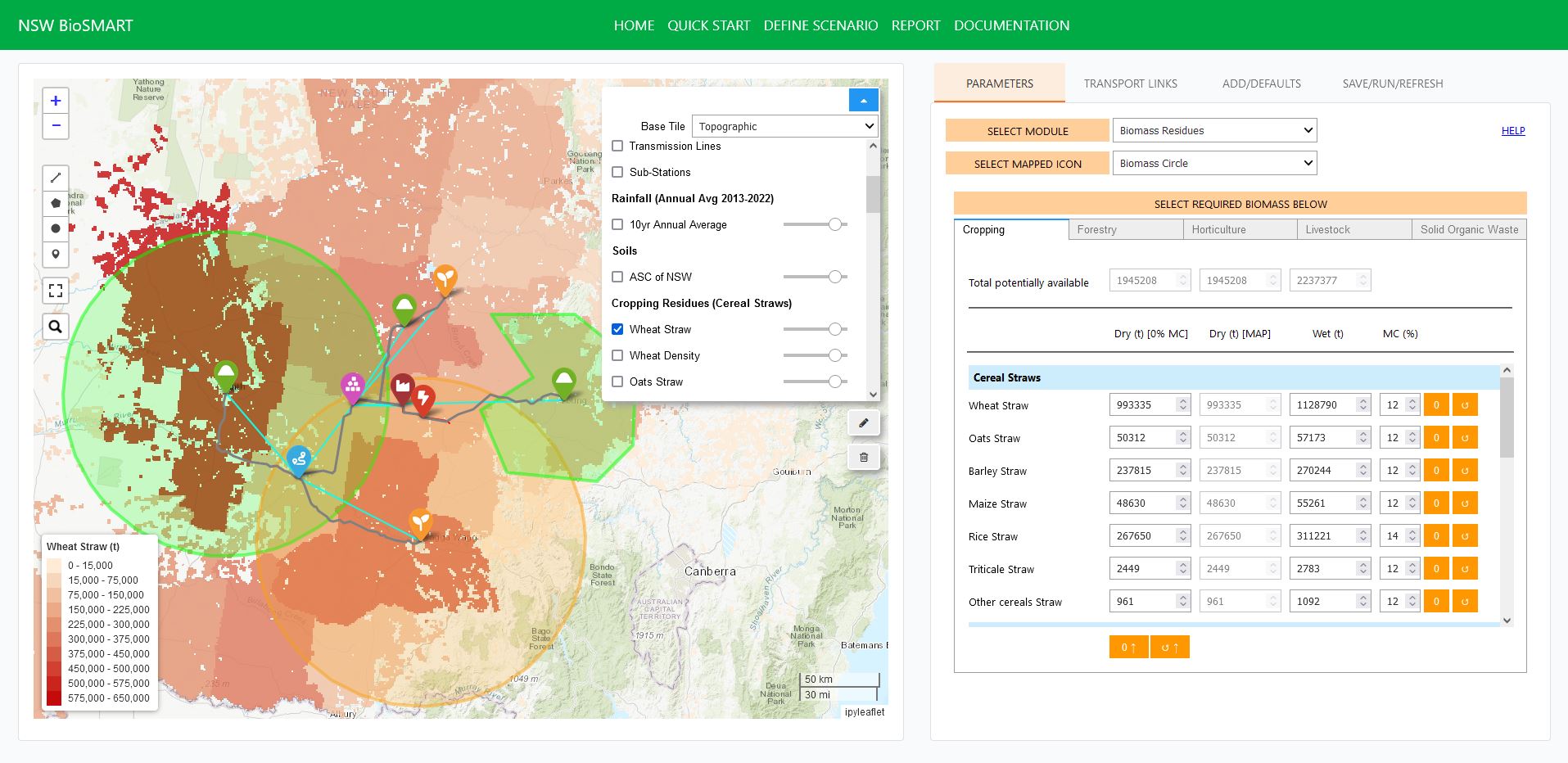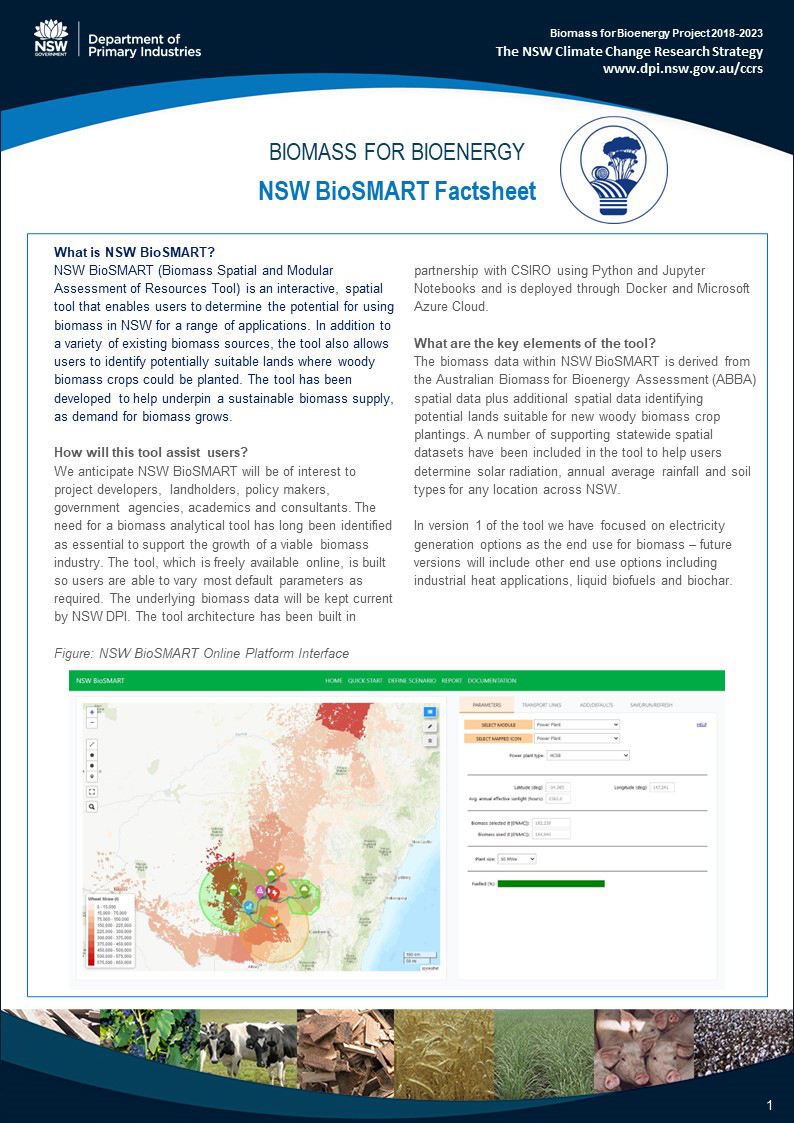
NSW BioSMART Tool
NSW BioSMART (Biomass Spatial and Modular Assessment of Resources Tool) is an interactive, spatial tool that enables users to determine the potential for using biomass in NSW for a range of applications. In addition to a variety of existing biomass sources, the tool also allows users to identify potentially suitable lands where woody biomass crops could be planted. The tool has been developed to help underpin a sustainable biomass supply, as demand for biomass grows.
The need for a biomass analytical tool has long been identified as essential to support the growth of a viable biomass industry. The tool is built so users are able to vary most default parameters as required. The underlying biomass data will be kept current by NSW DPIRD. The tool architecture has been built in partnership with CSIRO using Python and Jupyter Notebooks and is deployed through Docker and Microsoft Azure Cloud.
Key elements of the tool
The biomass data within NSW BioSMART is derived from the Australian Biomass for Bioenergy Assessment (ABBA) Project spatial data (mapped biomass residues from cropping, forestry, horticulture and livestock systems, and solid organic waste) plus additional spatial data identifying potential lands suitable for new woody biomass crop plantings. A number of supporting statewide spatial datasets have been included in the tool to help users determine solar radiation, annual average rainfall and soil types for any location across NSW.
In version 1 of the tool we have focused on electricity generation options as the end use for biomass – future versions will include other end use options including industrial heat applications, liquid biofuels and biochar. The main aim is for this tool to drive greater use of biomass in NSW in a sustainable way, meeting the needs of a growing bioeconomy. Greater biomass use will drive investment in regional NSW, with positive environmental outcomes.
Within the tool the user can:
- Visualise and extract data from the map – types, volumes and locations of potential biomass residues available across NSW, including identifying locations and volumes for new biomass sources in the form of short-rotation native woody crops;
- Enter their own biomass types and volumes, then identify the location on the map with a point feature for inclusion in the calculations;
- Determine the amount of biomass required to run different renewable technologies such as hybrid concentrated solar-biomass plants, coal/biomass co-firing plants and 100% biomass plants, including the use of pellet facilities if required;
- Determine the fuel costs and emissions associated with transportation of the biomass;
- Alter default energy contents of different biomass types, add additional biomass types not mapped and alter default transport settings to user defined values;
- Connect new facilities and plants to existing transmission lines and substations to determine distance of new lines;
- Summarise findings in a report that can be exported; and
- Save scenario models for future use that can be reloaded back into the tool.
Future updates
Future versions of the NSW BioSMART tool will include more end use options including industrial heat applications, liquid biofuels and biochar.
NSW DPIRD are currently updating existing biomass spatial datasets from the ABBA project with more recent source data. The ABBA datasets include cropping residues, forestry residues, livestock residues, horticultural residues and urban solid organic waste.
The ABBA datasets will be expanded to include additional biomass residues not previously captured in NSW. The new and updated spatial datasets will be included in the NSW BioSMART tool as they become available. The spatial data is also available on National Map.
NSW DPIRD maintains an extensive network of woody biomass crop trials across NSW - this work is allowing us to determine the potential productivity of a range of native woody crops managed on a short-rotation basis. As more data becomes available it will be incorporated into the tool.
Contact us
For information about this project please email:
Fabiano Ximenes | Leader & Senior Research Scientist
fabiano.ximenes@dpi.nsw.gov.au
Catherine Carney | Research Officer
cath.carney@dpi.nsw.gov.au




